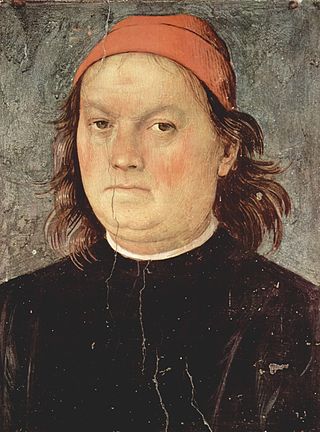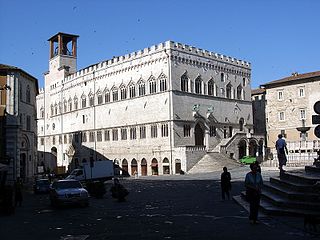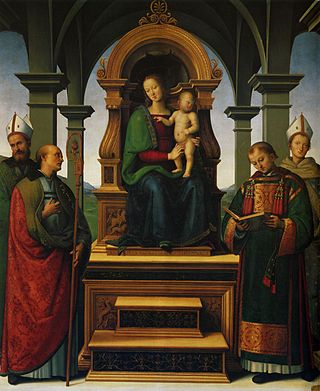
Perugia is the capital city of Umbria in central Italy, crossed by the River Tiber. The city is located about 164 km (102 mi) north of Rome and 148 km (92 mi) southeast of Florence. It covers a high hilltop and part of the valleys around the area.

Pinturicchio, or Pintoricchio, also known as Benetto di Biagio or Sordicchio, was an Italian painter during the Renaissance. He acquired his nickname because of his small stature and he used it to sign some of his artworks that were created during the fifteenth and sixteenth centuries.

Benedetto Bonfigli was an Italian Renaissance painter born in Perugia, and part of the Umbria school of painters including Raphael and Perugino. He is also known as Buonfiglio. Influenced by the style of Domenico Veneziano, Benozzo Gozzoli, and Fra Angelico, Bonfigli primarily painted frescos for the church and was at one point employed in the Vatican. His best-preserved work is the Annunciation, but his masterpiece is the decoration of the chapel of the Palazzo dei Priori. Bonfigli specialized in gonfaloni, a Perugian style using banners painted on canvas or linen. Little is known of his personal life, but he was an esteemed painter in Perugia before Perugino, who is said to be his pupil.

Pietro Perugino, an Italian Renaissance painter of the Umbrian school, developed some of the qualities that found classic expression in the High Renaissance. Raphael became his most famous pupil.

The Palazzo dei Priori or comunale is one of the best examples in Italy of a public palace from the communal era. It is located in the central Piazza IV Novembre in Perugia, Umbria. It extends along Corso Vannucci up to Via Boncambi. It still houses part of the municipality, and, on the third floor, the Galleria Nazionale dell'Umbria. It takes its name from the Priori, the highest political authority governing the city in the medieval era.

Bartolomeo Caporali was an Italian painter and miniaturist in Perugia, Umbria during the early Renaissance period. His style was influenced by Umbrian artists Gozzoli and Boccati, two of his first mentors, and continued to evolve as younger Umbrian artists came onto the scene, such as Fiorenzo di Lorenzo, Perugino and Pinturicchio. Although primarily a painter, he is also known for executing missals, restoration work, gilding, armorials, banners and celebratory decorations, which speaks to his decorative, detail-oriented artistic style. His most famous works include Madonna and Saints (1487) for the church of Santa Maria Maddalena at Castiglione del Lago, The Virgin and Child Between Two Praying Angels, and his Adoration of the Shepherds.

Andrea di Aloigi, called L'Ingegno, was an Italian Renaissance painter.

The Last Supper (1493–1496) is a fresco by the Italian Renaissance painter Pietro Perugino, located in the refectory, now museum, of the former Convent of Fuligno located on Via Faenza #42 in Florence, region of Tuscany, Italy.

The San Francesco al Prato Resurrection is a painting by the Italian Renaissance painter Pietro Perugino, dating to c. 1499. It is housed in the Pinacoteca Vaticana, Rome.

Decemviri Altarpiece is a painting by the Italian Renaissance artist Pietro Perugino, executed in 1495–1496, and housed in the Pinacoteca Vaticana in Vatican City.

The San Pietro Polyptych is a polyptych by Italian Renaissance master Perugino, painted around 1496–1500. The panels are now in different locations: the lunette and the central panel, depicting the Ascension of Christ, are in the Museum of Fine Arts of Lyon, France.

Domenico Bruschi was an Italian painter and educator. Bruschi also designed tapestries, Renaissance revival wooden furniture, sculptures in stucco and stained glass windows. Bruschi served as the chair of Ornamentor at the Institute of Fine Arts in Rome, was made an official Academician of the Accademia di San Luca, and named Commandatore for his excellence in painting.
Luberto da Montevarchi, also known as Roberto da Montevarchi or Il Montevarchi (1460-1522), was an Italian painter of the Renaissance period, active in the Valdarno.

Adoration of the Magi is a 1504 fresco by Perugino in the Oratorio di Santa Maria dei Bianchi in Città della Pieve. It shows the Adoration of the Magi, with an idealised view from Città della Pieve towards Lake Trasimene and Val di Chiana in the background. It is often compared to the Adoration of the Magi in the Sala delle Udienze del Collegio del Cambio in Perugia by Perugino and his studio, which includes areas argued by some art historians to have been painted by a young Raphael.

Madonna della Consolazione is an oil on panel painting by Perugino, datable ca. around 1496–1498. The work, completed in April 1498, was carried out in the Sala delle Udienze of the Collegio del Cambio. Since c. 1820 it is preserved in the National Gallery of Umbria in Perugia.

The Gonfalon of Justice is a tempera and oil on canvas painting by Perugino, dating to around 1501 and now housed in the Galleria Nazionale dell'Umbria in Perugia.

The Transfiguration Altarpiece is an altarpiece of the Transfiguration of Jesus by Perugino, dating to 1517 and now in the Galleria Nazionale dell'Umbria in Perugia.

St Sebastian between St Roch and St Peter is a fragment of a fresco by Perugino, painted around 1478 in the church of Santa Maria Assunta in Cerqueto, Italy. It was his first depiction of Saint Sebastian, a subject to which he would frequently return. To the left is St Roch and to the right St Peter.

Holy Trinity is a fresco in San Severo chapel in San Severo church in Perugia, executed by Raphael and Perugino.

Transfiguration is a signed oil-on-panel painting of the Gospel episode the Transfiguration of Jesus by Lorenzo Lotto, produced in 1510–1512 for the church of Santa Maria di Castelnuovo and now in the Museo civico Villa Colloredo Mels in Recanati. It may originally have had a predella, part of which is Christ Leading the Apostles to Mount Tabor.



















